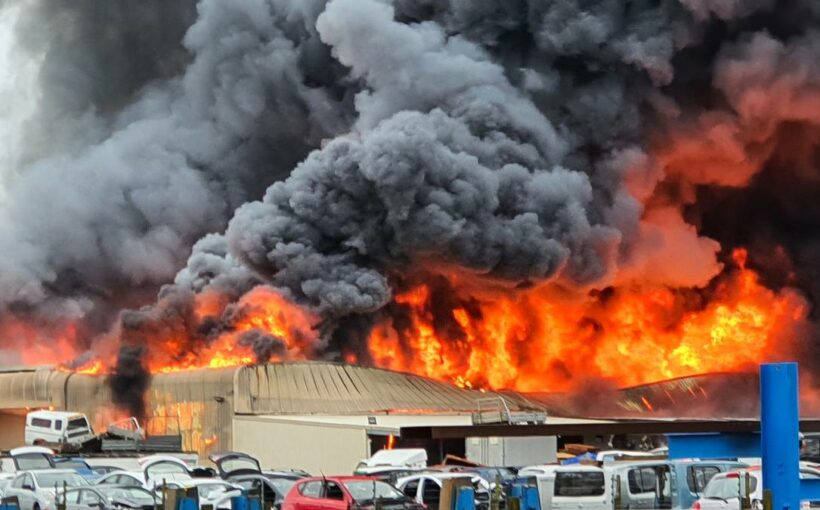Sometimes it’s just like the movies – loud explosions, fire balls and heaps of flames.
As Auckland City assistant area commander Roger Callister drove towards huge plumes of smoke coming from a fire at a Papakura scrap yard on Sunday afternoon he knew from experience it was going to be a late night.
“I knew I wasn’t going to be going home early and that I’d probably miss dinner,” he told the Herald.
As crowds gathered outside the Parker St scrap yard flames were ravaging buildings and hundreds of cars, triggering a safety warning for nearby residents to close their doors and windows.
Inside the fire ground up to 90 firefighters from across the city were battling the inferno – a job that involves navigating numerous hazards for everyone involved.
“There were some huge explosions,” said Callister, who has been in the force for more than 40 years.
Callister said scrap metal fires are especially hard to extinguish because there are materials like foam, plastic and residual fuels inside the car but the metal on the outside makes it waterproof, protecting the flames from the firefighters’ hoses.
And just to make Sunday’s battle harder the cars were stacked on top of each other, three high.
He said there are also dangers for firefighters – as the fire burns the rubber away from the car’s tires, the pile can become unstable and fall over.
“That’s one of the hazards we have to watch out for if we send firefighters in amongst the cars, the car toppling.”
Residents nearby reported hearing loud explosions and bangs, with one saying his house shook like a short, sharp earthquake.
The noises were coming from acetylene cylinders and LPG bottles that were exploding, with some big bangs that were projecting fireballs “like you see on TV”.
“There were a few eyes go wide,” he said of his colleagues. “They know their training, they know to protect themselves. We have had firefighters lose body parts in the past when these things have exploded.”
Firefighters are trained to be aware of projectiles from exploding cylinders. Large LPG installations can cause huge fireballs 500 metres in size.
He said crew concentrated on saving the one remaining building that hadn’t been destroyed by the fire.
They deployed the “external defensive” tactic, meaning they didn’t go inside any buildings but fought the flames from outside by pouring as much water as they could on it.
It’s a less strenuous tactic than “internal firefighting” where crew load air supply tanks on their backs, weighing a few kilograms, along with their gear and hoses. They’re often crawling on their knees to move along the floor to avoid the heat higher up.
Beyond the firefighters, scores of people work behind the scenes at big fires like this – such as FENZ operational support workers who organise things like food and drink for the crew.
Around 9.30pm on Sunday, a 20-tonne digger was hired to make a track into the car debris to make it easier for firefighters to continue extinguishing flames.
With the fire under control by then, Callister headed home, leaving other crews at the scene overnight dampening hotpots.
As he finally lay down exhausted in bed, he prayed his pager didn’t ping again as he was still on call.
“It’s happened when I’ve just got down and the pager will go again and there’s something else to go to.”
A lawyer for the scrap yard, Japanese Car Parts, said in a statement the company was devastated by the fire but relieved there were no injuries.
“We aregrateful to Fire and Emergency New Zealand for their massive efforts yesterday in controlling and putting out the fire.”
The company was assisting in the investigation into the source of the fire in “any way we can”.
“We are committed to our community in Papakura, and we are very sorry to our neighbourhood and our community for the disruption and inconvenience, and thank them for their support.”
Source: Read Full Article

/cloudfront-ap-southeast-2.images.arcpublishing.com/nzme/NLKPZJIQ56TNRNRHTP4LSYH7HM.jpg)
/cloudfront-ap-southeast-2.images.arcpublishing.com/nzme/YW74V3LRACALSRUAG2KRNBQ4KU.jpg)
/cloudfront-ap-southeast-2.images.arcpublishing.com/nzme/QCFHK7KDYD72EYDTJV54IWV3AI.jpg)
/cloudfront-ap-southeast-2.images.arcpublishing.com/nzme/C7NBAJ4HVYRWRJJPOLJHQL4P3A.jpg)
/cloudfront-ap-southeast-2.images.arcpublishing.com/nzme/7H665TXIGXN2HIHZ4HIWI4GQW4.jpg)